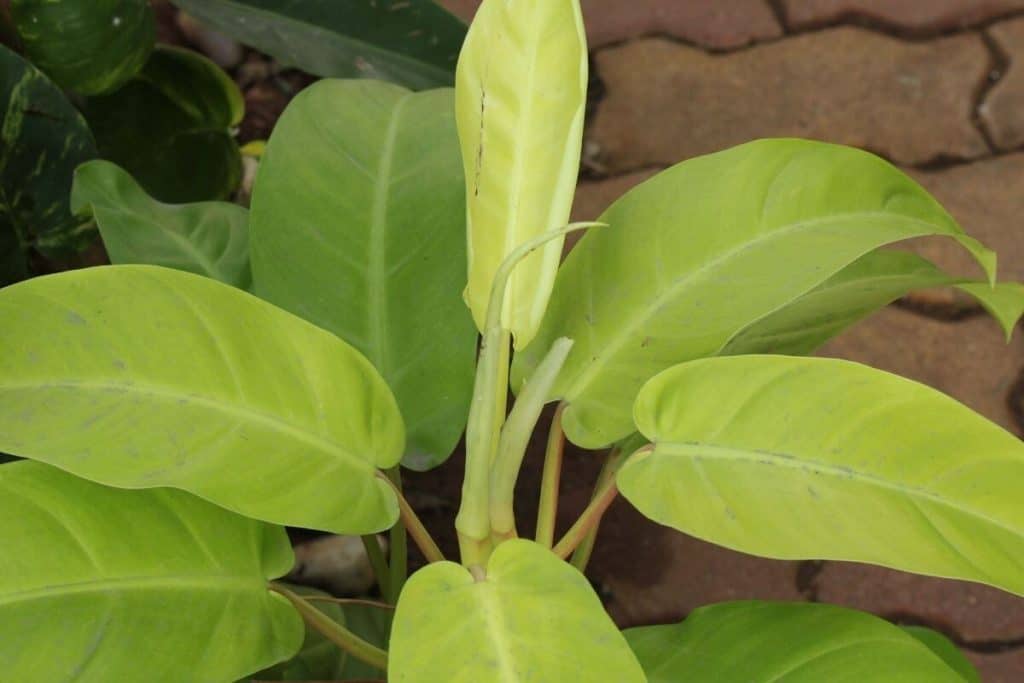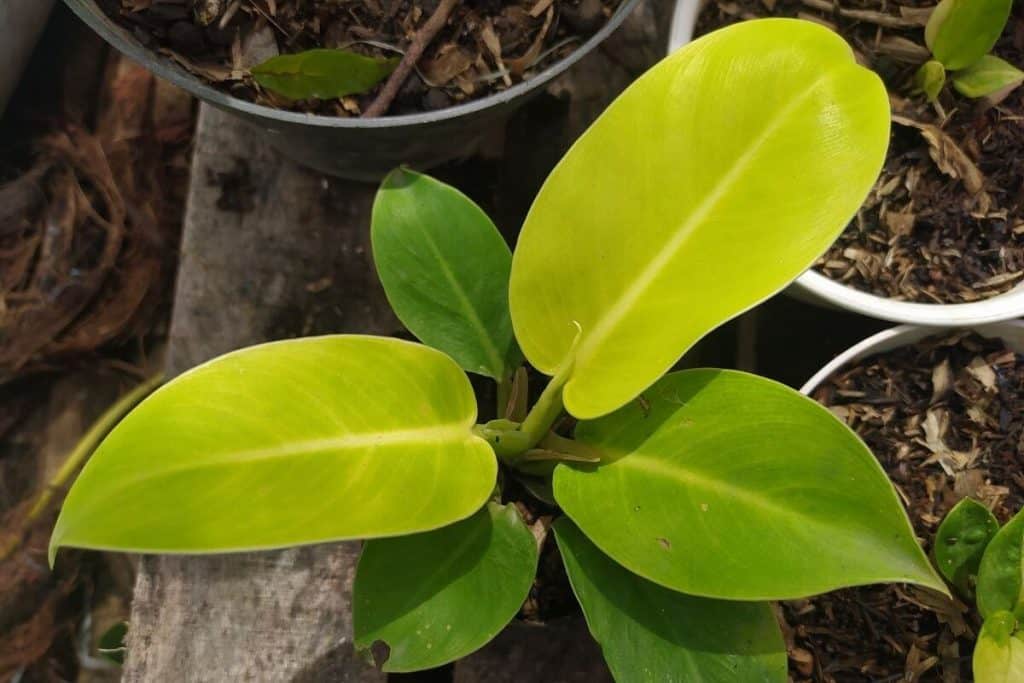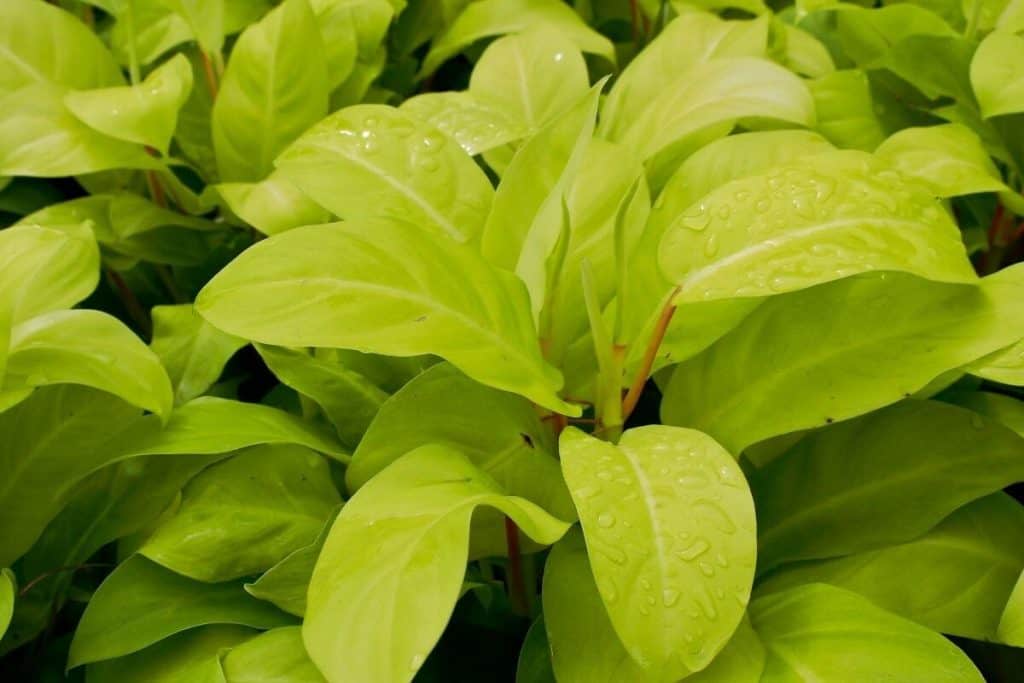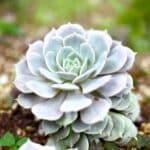Are you part of the lucky ones that possess a Philodendron red moon? You should consider yourself fortunate because this variety of Philodendrons is extremely rare. This plant is characterized by lime green foliage, splashed with dashes of bright red.
Can you imagine the beauty?
If you have this rare plant, you need to do everything within your power to ensure that this plant is adequately cared for.
This article discussed everything you need to know about the best Philodendron Red Moon care and growing tips. The Philodendron Red Moon thrives best in bright indirect sunlight, a well-draining soil mix, and prefers mildly moist soil.
We will get into an in-depth discussion on how to care for Philodendron Red Moon.
Table of Contents
What is Philodendron Red Moon?
As mentioned, the Philodendron Red Moon is a rare plant, and thus you should consider yourself lucky if you have one.
The Philodendron Red Moon grows in warm, moist forests and is characterized by its bright pale lime foliage with deep red streaks running throughout every other leaf.
As this plant matures, the leaves change into a tropical darker green, and the stem takes on a darker red color.
Sometimes the leaves grow in full red with yellow splotches, or the red and yellow can be in equal proportion in some varieties of this plant.
The vibrant red and yellow splashes on the leaves of Philodendron Red Moon do not contain chlorophyll, so your plant needs to have both green and red leaves.
Since this plant grows in warm, moist forests, you will have to replicate its growing conditions, such as bright indirect sunlight, to care for the plant.
Philodendron Red Moon Care and Growing Tips

As mentioned, the trick to perfectly caring for your Philodendron Red Moon is to simulate the conditions where it's naturally grown as much as possible.
What are these natural conditions, and how can this feat be achieved? That's precisely what you'll learn from this post.
Related Post: Philodendron Cordatum Vs Hederaceum
Philodendron Red Moon Soil Requirements
Since the Philodendron Red Moon grows in warm, moist forests, it follows that this plant will thrive in a fast-draining, moist aroid potting mix filled with organic matter.
The potting mix of Philodendron Red Moon should be a combination of coco coir, orchid bark, perlite, and horticultural charcoal in high-quality potting soil.
You can even add worm castings to the topsoil of the potting mix. This is a natural fertilizer and an optimal soil enricher.
Please ensure you don’t use wet, mucky, or dry, sandy soils for your Philodendron Red Moon. This plant is prone to be overwatered, which will result in root rot. The right type of soil keeps the plant healthy and aerated.
If you are growing the Philodendron Red Moon from the seeds, chances are the seeds are imported, given how rare these plants are.
If such is the case, make sure to add some diluted superthrive to your soil. This will relieve the seed of stress after long transits.
Philodendron Red Moon Light Requirements
Remember that the Philodendron Red Moon grows in warm, moist forests where long trees serve as a canopy and provides filtered light. It follows that this plant will thrive in bright, indirect sunlight.
To mimic this natural condition of ‘filtered light,’ place the plant close to a window covered with a thin curtain, shade. The Philodendron Red Moon can survive in lower light conditions but thrives best in filtered sunlight.
You do not want to subject your Philodendron Red Moon to bright, direct sunlight bouncing straight onto its leaves. Such conditions will lead to browning edges or even blackened scorch marks on its delicate leaves.
Related Post: Philodendron Thai Sunrise Vs Golden Goddess
Philodendron Red Moon Water Requirements
You need to water the soil of your Philodendron Red Moon regularly, making sure the soil is moist and damp since the plant naturally grows in wet, moist soil.
But do not make the mistake of growing the moisture-loving Philodendron Red Moon in wet, mucky, and waterlogged soil! Since this plant is prone to be overwatered, it will lead to root rot.
Do not water the leaves from overhead but make sure to water the plant at the roots until the top inch of soil is moist.
Provided the Philodendron Red Moon is planted in a well-draining potting mix, the entire root system will receive adequate water because
Whenever the soil starts clumping together or begins to pull away from the sides, that is your cue to water it.
Philodendron Red Moon Temperature Requirements
Most Philodendron varieties thrive best in an ideal temperature between 65 – 78°F; the Philodendron Red Moon can go as low as 60 Degrees Fahrenheit and as high as 80 Degrees Fahrenheit.
Remember that the Philodendron Red Moon thrives in warm forests; thus, keeping this plant in a relatively warm environment is always safer if you want the leaves to have richer colors.
Don’t allow the temperature to drop below 55 Degrees Fahrenheit; otherwise, you risk shocking your plant, causing a slow, stagnant, and less than stellar growth.
Philodendron Red Moon Humidity Requirements
From the little you’ve learned about the Philodendron Red Moon, you should be able to deduce that this falls in the category of humidity-loving plants!
Suppose you want your Philodendron Red Moon to have smooth, thick, glossy, and healthy leaves. In that case, you'll want to make sure your Philodendron red moon is receiving medium to high humidity.
Remember that the trick is to replicate its natural growing conditions, right? The forest in which the Philodendron Red Moon grows has high humidity levels. Thus, you may want to look for practical ways to raise the humidity of your beautiful Philodendron Red Moon.
To do this, use a digital hygrometer to check the humidity level surrounding your plant’s new location. If the humidity level is low, use a humidifier to increase the humidity levels.
Alternatively, you can group plants with similar humidity levels together to create a ‘humidity sharing biome.’
You can also place your Philodendron Red Moon in a tray of water with pebbles. Ensure that the pot is touching the pebbles and not the water. As transpiration takes place, it will naturally boost the humidity level surrounding your plant.
Related Post: Brazil Pothos Vs Philodendron
Philodendron Red Moon Fertilizer Requirements
The philodendron red moon can actually do without fertilizers. But we recommend that you fertilize the plant during the spring and summer growing months.
What type of fertilizer is best suited for the Philodendron Red Moon? We recommend a complete liquid fertilizer free of urea like Dyna Grow Pro or the 7-9-5 formulation.
These fertilizers contain all 16 macro and micronutrients your philodendron will need, and it's very low in heavy residue salts.
To fertilize your Philodendron Red Moon, dilute ¼ teaspoon of Dyna Grow with a gallon of fresh water to feed your plants.
Dyna Grow contains the essential nutrients your Philodendron Red Moon needs, like nitrogen, phosphorus, and potassium.
Nitrogen encourages leaf growth; phosphorus helps a plant convert nutrients into energy; potassium encourages healthy root, stem, and leaf development.
How to Repot Philodendron Red Moon

Being a big plant, especially under the right conditions, you need to repot your Philodendron Red Moon every once the plant gets too big for its current container.
The philodendron red moon doesn’t cope too well with bound roots. Thus, you will need to repot it once the plant shows these signs:
- The first sign that your Philodendron Red Moon needs to be repotted is when it has obviously outgrown its pot or container.
- Secondly, if the foliage is growing dense and bushy, this is your cue to report.
- If your Philodendron Red Moon is planted in a clear decorative pot, a simple glance will tell you that its root system is bound.
- Stunted or poor growth might be another telltale sign that your Philodendron Red Moon needs to be repotted ASAP. Although, other factors like poor potting mix can account for stunted and poor growth
- Once roots show through the drainage holes, you need to repot your Philodendron Red Moon in a bigger pot or container.
Note that repotting is recommended once your Philodendron Red Moon starts to exhibits these signs outlined above.
It needs to be carefully done since repotting can cause some minor distress. How do you go about repotting your Philodendron Red Moon?
Well, follow the tips below:
- It's best to repot your Philodendron Red Moon at the beginning of spring. This is the growth phase of this plant and thus makes it safer to repot.
- Always go for a pot that is 2-3 inches wider than the last pot. Your Philodendron Red Moon needs space and will thrive better when its roots are allowed to broaden and splay out.
- And obviously, the new pot should have drainage holes.
- Make sure to use high-quality potting soil with organic content in the new pot or container.
How to Prune Philodendron Red Moon
You will have a big Philodendron Red Moon in your hands once the plant is growing under the right conditions. How do you deal with the thick and dense foliage?
You can opt for the occasional pruning once or twice a year to maintain the plant's shape. This is also an excellent opportunity to gift family and friends stem cuttings of Philodendron Red Moon, given how rare this plant is.
Before pruning, remove dead, damaged, brown and yellow leaves or any leaves showing signs of pest infestations.
To prune, use a clean pair of pruning scissors or sharp knives and cut at the smaller stems that hold the individual leaves.
Do not cut the main trunk or aerial roots that shoot outside the pot. Aerial roots add stability to your plant, and cutting them off might damage the plant.
How to Propagate Philodendron Red Moon
Stem cutting is the best and easiest way to propagate your Philodendron Red Moon.
Chose a mature stem and cut it off with a pair of clean scissors or knife. You can plant the stem cuttings in rich, organic soil or try out the water propagation method by placing the stem cuttings in water.
Although, it has been discovered that the stem cuttings of Philodendron Red Moon develop stronger roots when in a high-quality potting mix.
Follow the steps below to propagate your Philodendron Red Moon:
- Find a healthy stem that has a good, strong leaf on it.
- Prepare the potting mix. Ensure that the potting mix is moist with well-draining soil mixed with organic matters.
- Use a clean pair of pruning scissors or a sharp knife to cut the stem. The stem cutting should be around 3-5 inches in size.
- Dip the stem cuttings in a rooting hormone solution or powder for few days.
- Transfer the stem cutting into your pre-made potting mix.
- Make sure the stem cuttings are placed in a warm area that receives bright, indirect light.
- Water regularly. In about 3-5 weeks, roots should develop, then you can move to a bigger container.
Common Pests that Affect Philodendron Red Moon

While the Philodendron Red Moon is quite resilient to most pests, some stubborn pests like Mealybugs, Scales, Thrips, and Aphids still find a way to attack this beautiful plant.
Most of these pests find their way into attacking this plant when the soil is contaminated or due to poor sanitation.
Luckily, most pests that attack the Philodendron Red Moon can easily be removed with some neem oil which is an eco-friendlier option to most synthetic insecticides.
Always dilute the neem oil as recommended on the package before applying it to your plant to dislodge these pests. Neem oil can be purchased in most garden centers, on Amazon, or Etsy.
Diseases that Affects Philodendron Red Moon: Philodendron Red Moon Problems
Erwinia Blight Disease is one of the commonest diseases that affect Philodendron Red Moon. The Erwinia Blight Disease is a bacterial infection that causes wet, see-through mushy-looking patches on the plant.
This disease is quite serious and can kill your beautiful Philodendron Red Moon in days. The Erwinia Blight Disease happens when the plant is overwatered or when you water the plant from the leaves (this is exactly why misting is not recommended for Philodendron Red Moon).
Once the Erwinia Blight Disease attacks your Philodendron Red Moon, it moves quickly and spreads through the stem and leaves of your plant.
You can prune out the affected leaves if the disease is still in the early stage, but once it has affected all your leaves and stem, you might have to abandon your beautiful Philodendron Red Moon.
Frequently Asked Questions
Is the Philodendron Red Moon Toxic?
Yes, the Philodendron Red Moon is toxic when ingested, just like most varieties of Philodendron. Thus, you may want to keep your Philodendron Red Moon away from cats, dogs, and small children.
Can the Philodendron Red Moon be Categorized as a Climbing Plant?
Yes, the Philodendron Red Moon is a climbing plant and can grow in hanging baskets if you wish. This is true for most Philodendron varieties – they've strong aerial roots and tend to climb when matured.
How Much is A Philodendron Red Moon?
Remember that we mentioned that Philodendron Red Moon is a rare, unique plant. Well, you may have to save up before buying this beautiful philodendron variety. Philodendron Red Moon ranges between $1800 to $2400.




